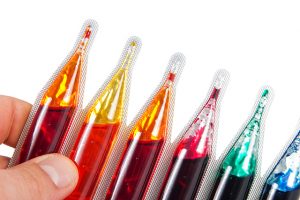
Red 3 – toxicity, side effects, diseases and environmental impacts
Tuesday, November 21, 2017 by Michelle Simmons
http://www.naturalpedia.com/red-3-toxicity-side-effects-diseases-and-environmental-impacts.html

Red 3 is an organoiodine compound, particularly a derivative of fluorone. It is an organic compound that contains iodine and sodium. It is a cherry-pink or red synthetic color additive made from coal tar that gives a pink shade to applications. This chemical is used as a food coloring, in printing inks, as a biological stain, a dental plaque disclosing agent, and a radiopaque medium. In addition, it was used as a sensitizer for orthochromatic photographic films. Red 3 can also be identified in the names Erythrosine and FD&C Red 3. It has the molecular formula of C20H8I4O5 . Red 3, as a food additive, has the E number E127. The use of Red 3 is banned in Norway and in the U.S.

List of known side effects
According to an entry by LiveStrong.com, a study on Red 3 conducted in animals revealed that the synthetic dye acted as a cancer-causing chemical. In addition, there have been concerns that the chemical may affect thyroid and increase the risk of thyroid tumors. Food processing at temperatures over 200 degrees Celsius degrades Red 3, which releases iodide. This could affect the activity of thyroid, increase thyroid hormone levels, and lead to hyperthyroidism. In addition, the Hyperactive Childrens Support Group believes that Red 3 increases the risk of hyperactive behavioral disorders in children. Red 3 may also be harmful if swallowed. It may also cause environmental harm, particularly to the aquatic environment.
Body systems affected by Red 3
There are a few body systems that can be adversely affected by Red 3, such as the endocrine system and the nervous system.
Items that can contain Red 3
There are a lot of items that contain Red 3. These include pharmaceutical products, cosmetic products, and food products, such as cocktails, glace and tinned cherries, biscuits, canned fruit, custard mix, sweets, chocolate, dressed crabs, garlic sausage, luncheon meat, salmon spread, pate, scotch eggs, stuffed olives, sweets, bakery and snack foods, and packet trifle mix. The coal tar dye is also used in dental disclosing tablets to reveal plaque.
How to avoid Red 3
One way to avoid Red 3 is to check the labels of food and other products if they contain the synthetic dye. This will help you refrain from consuming pharmaceutical products, cosmetic products, and food products, such as cocktails, tinned fruits, biscuits, chocolate, dressed crabs, garlic sausage, luncheon meat, salmon spread, pate, scotch eggs, stuffed olives, sweets, bakery and snack foods that contain Red 3.
Where to learn more
- Xenoestrogens: A Culprit of Hormone Imbalance! The Warning Signs You Are in A State of Imbalance.
- Your Daily Additives – Dye Week – Aluminum Lake
- Know what you eat before you eat it
- Call for Ban on Eight Dangerous Food Dyes in U.S. Foods
- Know what’s In your food (opinion)
Summary
Red 3, also known as Erythrosine and FD&C Red 3, is a cherry-pink or red synthetic color additive made from coal tar that gives a pink shade to applications. It is used as a food coloring, in printing inks, as a biological stain, a dental plaque disclosing agent, and a radiopaque medium. It was also used as a sensitizer for orthochromatic photographic films.
Red 3 may affect the thyroid and increase the risk of thyroid tumors.
Red 3 may cause cancer.
Red 3 may cause hyperactive behavioral disorders in children.
Red 3 is toxic to the aquatic environment.
Sources include:
Tagged Under: Tags: Red 3





